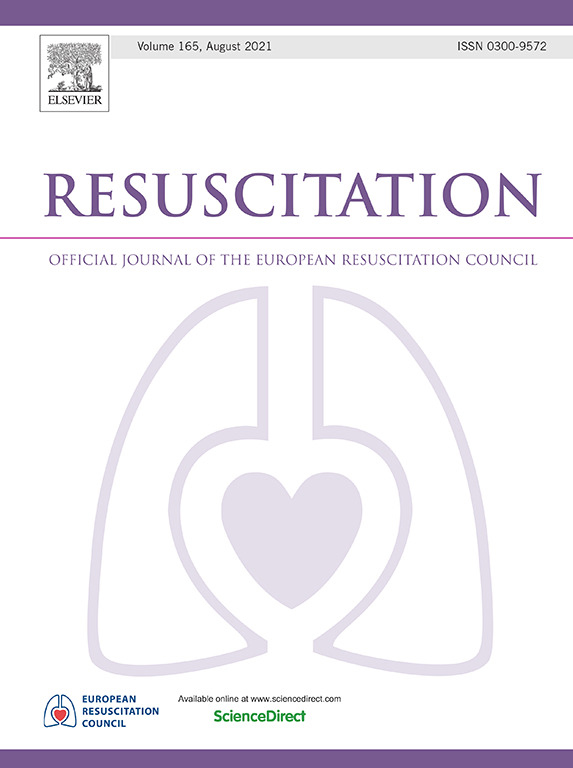Does the effectiveness of advanced airway management depend on initial cardiac arrest rhythm? A secondary analysis of the pragmatic airway resuscitation trial
IF 4.6
1区 医学
Q1 CRITICAL CARE MEDICINE
引用次数: 0
Abstract
Background
Over 70% of patients with out-of-hospital cardiac arrest (OHCA) present with a non-shockable initial rhythm, asystole or pulseless electrical activity (PEA), which is associated with lower survival than a shockable initial rhythm. Advanced airway management and oxygen delivery are important OHCA interventions, but their impact based on different presenting rhythm groups are incompletely defined. Our objective was to determine if advanced airway strategy is associated with outcomes in shockable, PEA and asystolic OHCA.
Methods
We performed a secondary analysis of data collected from the Pragmatic Airway Resuscitation Trial (PART), which assigned adults with OHCA to a strategy of either endotracheal intubation (ETI) or laryngeal tube (LT) for initial advanced airway management. We stratified patients by initial cardiac rhythm: shockable (ventricular fibrillation/pulseless ventricular tachycardia (pVT), AED shock), PEA or asystole. We excluded AED non-shockable and unknown rhythms. The primary outcome was 72-h survival. Secondary outcomes included return of spontaneous circulation (ROSC) at emergency department arrival, survival to hospital discharge, and survival with good neurological function (modified Rankin score ≤3). We used general estimating equations to determine the associations between airway strategy initial arrest rhythm and outcomes, adjusted for age, sex, witnessed status, and bystander CPR.
Results
There were 3004 patients in the parent trial of which 2847 were included in this analysis. Of these 575 (20.2 %) were shockable, 671 (23.6 %) were PEA, and 1601 (56.2 %) were asystole. Compared with ETI, LT airway use was not associated with improved 72-h survival in shockable rhythms (adjusted [AOR] 1.30 (0.91, 1.67)), PEA (AOR 0.97 (0.65, 1.45)), or asystole (AOR 1.13 (0.79, 1.64)). Similarly, we noted no significant interaction between airway strategy and initial rhythm for the secondary outcomes of ROSC, survival to discharge, and survival to discharge with good neurological function.
Conclusion
Prehospital advanced airway management strategy (ETI vs. LT) was not significantly associated with outcomes regardless of initial cardiac rhythm.
先进气道管理的有效性取决于初始心脏骤停节律吗?实用气道复苏试验的二次分析。
背景:大约80%的院外心脏骤停(OHCA)患者表现为非休克性初始节律、无搏动或无脉性电活动(PEA),其生存率低于休克性初始节律。先进的气道管理和供氧是重要的OHCA干预措施,但其基于不同呈现节奏组的影响尚未完全确定。我们的目的是确定先进的气道策略是否与休克、PEA和无收缩期OHCA的结果相关。方法:我们对实用气道复苏试验(PART)收集的数据进行了二次分析,该试验将OHCA成人患者分配到气管内插管(ETI)或喉管(LT)进行初始高级气道管理。我们根据初始心律对患者进行分层:可休克(室颤/无脉性室性心动过速(pVT), AED休克),PEA或asystle。我们排除了AED非震荡和未知的节奏。主要终点为72小时生存期。次要结局包括急诊科到达时的自发循环恢复(ROSC)、存活至出院,以及神经功能良好的存活(修正Rankin评分≤3)。我们使用一般估计方程来确定气道策略、初始骤停节律与结果之间的关系,并根据年龄、性别、目击状态和旁观者CPR进行调整。结果:母试验共有3004例患者,其中2847例纳入本分析。其中,休克575例(20.2%),PEA 671例(23.6%),心搏停止1601例(56.2%)。与ETI相比,LT气道使用与休克节律(调整[AOR] 1.30(0.91, 1.67))、PEA (AOR 0.97(0.65,1.45))或心脏骤停(AOR 1.13(0.79, 1.64))下72小时生存率的提高无关。同样,我们注意到气道策略和初始节律在ROSC的次要结局、存活至出院和存活至出院时神经功能良好之间没有显著的相互作用。结论:院前先进气道管理策略(ETI vs. LT)与预后无显著相关,与初始心律无关。
本文章由计算机程序翻译,如有差异,请以英文原文为准。
求助全文
约1分钟内获得全文
求助全文
来源期刊

Resuscitation
医学-急救医学
CiteScore
12.00
自引率
18.50%
发文量
556
审稿时长
21 days
期刊介绍:
Resuscitation is a monthly international and interdisciplinary medical journal. The papers published deal with the aetiology, pathophysiology and prevention of cardiac arrest, resuscitation training, clinical resuscitation, and experimental resuscitation research, although papers relating to animal studies will be published only if they are of exceptional interest and related directly to clinical cardiopulmonary resuscitation. Papers relating to trauma are published occasionally but the majority of these concern traumatic cardiac arrest.
 求助内容:
求助内容: 应助结果提醒方式:
应助结果提醒方式:


